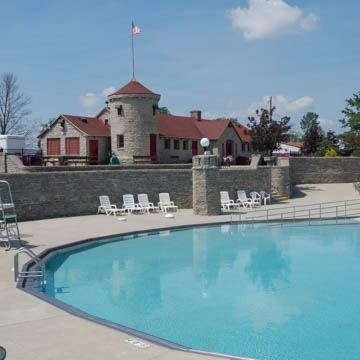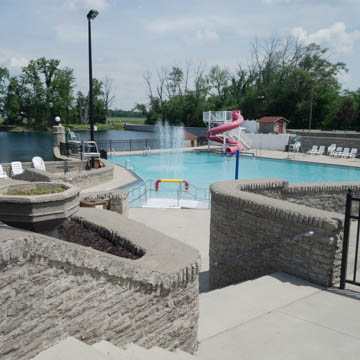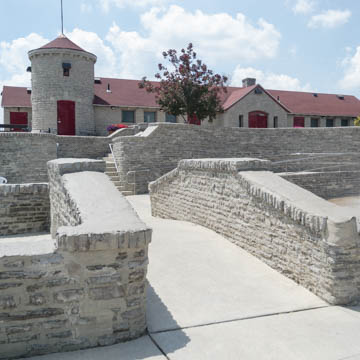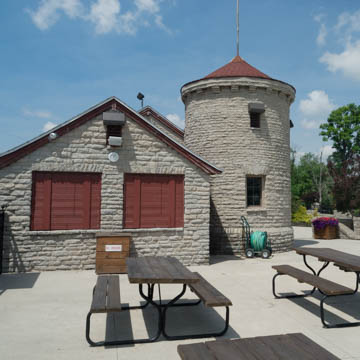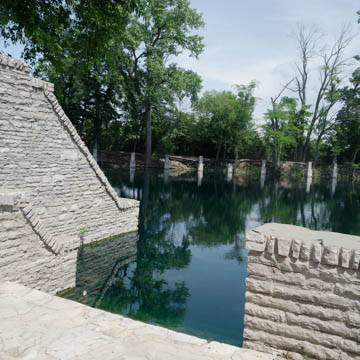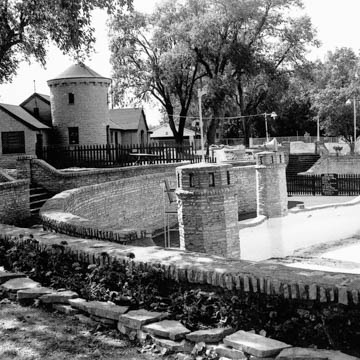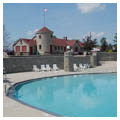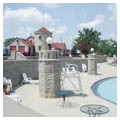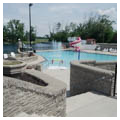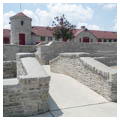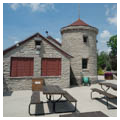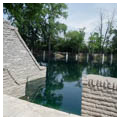Columbus Grove Municipal Pool and bathhouse is a whimsical example of a Works Progress Administration (WPA) recreational project, constructed of hand-cut stone and executed in a Norman Revival design with the towers, turrets, and curving walls depicting a life-size sand castle. An impressive product of the public work relief program under Franklin Roosevelt’s New Deal, Columbus Grove Municipal Pool was constructed to provide employment to local citizens in a time of need and to give Putnam County its first municipal swimming pool. Using readily available local resources, including untrained labor and stone from an existing quarry, the pool, bathhouse, walls, and walkways were built entirely by hand by local residents on the federal payroll.
The pool and bathhouse were built on the site of a spring-fed abandoned stone quarry that was incorporated into the design of the complex. Using the boundary of the quarry as the northern wall, a main pool and secondary wading pool for children, connected by a footbridge, were constructed of laid up coursed limestone. Stylistic elements include the conical roofed turret, segmented arches with keystones and hand-hewn mortise-and-tenon timber joints. Architectural detailing is restrained; the pool and bathhouse illustrate WPA preferences for simple schemes, bereft of ornate features or intricate structural plans that would be difficult to execute without skilled local labor. Here, the result is a playful interpretation of a medieval castle complete with towers, turrets, walls, and moats.
The Columbus Grove Municipal Pool was a collaboration among local officials, the federal government, and men and women desperate for employment during the Great Depression. Hoping to gain federal funding, Columbus Grove Village administrators positioned themselves to successfully apply for a public works project. In 1934, the Columbus Grove Fish and Game Protective Association was formed to raise funds to purchase the quarry, which it then deeded to the Village. With Village support and ninety percent of the project’s labor force provided by those on relief, the WPA accepted the project and construction began in the fall of 1935. The pool and bathhouse were built by using pitch bars to quarry large blocks of stone which were transported by horse drawn carts or flatbed trucks to be hand chiseled to their final dimensions. Once the walls were in place, the floors of the pools were finished with concrete. The pool was opened with a community-wide celebration in September 1936. It continues to serve residents of Putnam County in its original function as an important local recreational facility. A recently completed renovation rebuilt the main pool to a smaller size and replaced the wading pool with fountains.
References
Paquette, John E., Historic Landmarks Foundation of Indiana, “Columbus Grove Municipal Pool,” Putnam County, Ohio. National Register of Historic Places Inventory-Nomination Form. National Park Service, U.S. Department of the Interior, Washington, DC.
Columbus Grove Pool and Shelterhouse (Bathhouse), Record Group 69, Records of the Work Projects Administration, National Archives and Records Administration, College Park, Maryland.

















